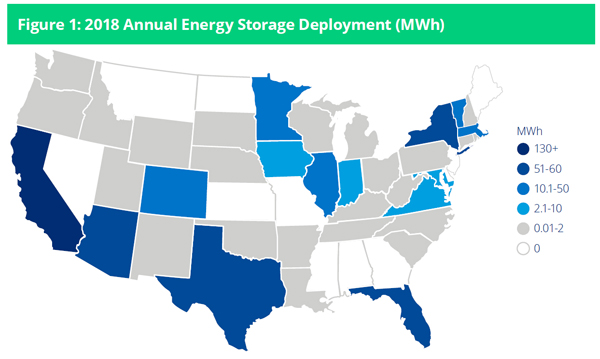By Cecilia Keating, SEPA
Installations of energy storage in the United States jumped by 44.9% last year, according to trade body the Smart Electric Power Alliance (SEPA).
A new report from the organization estimates a grand total of 760.3 MWh of energy storage was interconnected US-wide in 2018, hitting a cumulative market size of 1,966.6 MWh.
 According to SEPA, investor-owned utilities (IOUs) dominated last year, accounting for 64.3% (488.6 MWh) of nation-wide energy storage installations. However, public power utilities and electric cooperatives were on catch-up mode after seeing a dramatic ramp-up in 2018, SEPA found. They interconnected 271.7 MWh of storage last year – a whopping 300% jump from 2017. Public power was the fastest growing segment, increasing by more than 1,400%.
According to SEPA, investor-owned utilities (IOUs) dominated last year, accounting for 64.3% (488.6 MWh) of nation-wide energy storage installations. However, public power utilities and electric cooperatives were on catch-up mode after seeing a dramatic ramp-up in 2018, SEPA found. They interconnected 271.7 MWh of storage last year – a whopping 300% jump from 2017. Public power was the fastest growing segment, increasing by more than 1,400%.
Non-residential storage grew by 34.9%, with deployments totalling 189.9 MWh. California interconnected more non-residential storage than any other state, at 151.9 MWh, trouncing runners-up Colorado (18 MWh connected) and New York (12.3 MWh).
Residential storage deployments quintupled in 2018 from the previous year and totalled 189.9 MWh. Residents in California, Hawaii and Vermont led the charge, interconnecting 99.9 MWh, 33.6 MWh and 13.5 MWh respectively.
According to Mac Keller, co-lead author and research associate at SEPA, the US storage market is “primed for continued growth” from its current size of 1,966.6 MWh.
“Energy storage deployments are accelerating, driven by increasingly compelling economics and favourable state policies and residential programs in California, Hawaii, and Vermont. Beyond traditional back-up generation, storage is able to provide ancillary services, ramping, smoothing, peaking and baseload generation services to meet the demands of an increasingly diversified and distributed electrical system,” he said.
The report notes that the cost of building lithium-ion storage assets has declined by 72.9% since 2013.
The report is available at no cost from sepapower.org.
